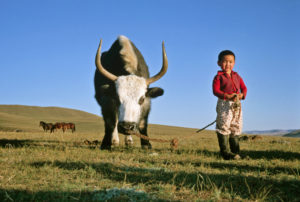“Barbarians at the gates.” That is the phrase has become inextricably associated with the collapse of the Western Roman Empire, a description and an explanation. It conjures up an image something like Thomas Cole’s “Destruction” painting from his Course of Empire series. The sky a maelstrom of darkening clouds, classical architecture wreathed in fire — and barbarian hordes marauding through the streets. But, while a popular-historical meme, it nonetheless descends from a genuine reality.
Because immigration played no small part in the demise of Rome. The period from the late-4th century to the mid-6th is frequently even termed “the Migration Period” or, in the more thunderous German, the Völkerwanderung. That long century was shaped the new ethnic groups that moved into the Empire from central and eastern Europe, spurred on by an initial exodus of population from the Eurasian steppe. The exact causes of this exodus — climate change, overpopulation, the building of the Great Wall of China — are ceaselessly debated by historians. But by 500 AD, with Anglo-Saxons north of the Channel, and Vandals, Franks, Goths further south, the vast majority of the ex-imperial landmass was ruled by newly arrived dynasts and warrior groupings.
For some modern commentators, however — from Boris Johnson to Pat Buchanan — the history does not stop there, and there is an immediate modern parallel. If, they argue, the United States and its Western allies represent something like a new empire, it too is threatened with invasion by incoming migrant hordes. And they see these hordes most visibly in the vast migration of peoples currently taking place across America’s southern border with Mexico, and through the Mediterranean world from North Africa.
But, while the historical comparison between Rome and the West has an attractive simplicity, there are fundamental disanalogies. Rome’s economy was overwhelmingly agricultural, and steady-state. Its GDP could not increase in anything but the very long term, since the stock of good land was fixed and farming methods slow to improve. Therefore the establishment of the Western successor states necessitated the partial or sometimes total (as in southern Britain) confiscations of wealth-generating agricultural assets from their existing owners to support their new rulers. In other words, migrants did literally and materially displace the Romans.
In comparison, wealth generation in the West — which is neither steady-state nor agricultural — has become effectively dependent on flows of migrant labour. Since 1900, average family sizes have declined dramatically across the developed world: currently only Iceland and Israel are producing the canonical 2.1 average children per adult female for the current population to reproduce itself in the next generation. Everywhere else, birth rates are below this level and in some cases — particularly Germany, Hungary, and Japan — far below. Therefore, immigrants aren’t appropriating wealth from the West, but supplementing a shortfall in the productive workforce. Which is why every 1% increase in legal migrant numbers — and the overwhelming majority of migrants into the west do arrive legally — adds an average 2% to GDP in Western countries, and average unemployment rates have not increased despite all the recent population inflows.
But, if we expand the discussion of modern migration to include its non-Western dimensions, a different comparison with Rome offers another, much more compelling parallel. Because the obsessive media coverage of Mexico and the Mediterranean refugee crises actually elides the most important modern migration story of them all. Apart from those arriving in the West, many times more people (countless millions in fact) have been on the move within the developing world. It is this new age of migration, the largest movement of people in the entirety of human history, which poses the real challenge to continued Western economic prosperity.
It began as a by-product of colonial-era economic development in the 19th century. As the rapidly industrialising West’s demand for raw materials from its colonial territories grew, as well as for foodstuffs for its expanding urban populations, new networks of connection grew up across the different empires: based on ports, internal river systems, and, eventually, railways. Former subsistence peasant producers across Asia, Africa, the Caribbean and South America found themselves sucked into these networks in ever-increasing numbers to provide the labour for new cash crops, raw material production, and to establish and run the transport networks.
The process only accelerated under the newly independent governments of ex-imperial territories in the years after 1945. Many devoted considerable resources to basic education, attempting to create homegrown industrial bases to fend off expensive imports from their former masters. And this sucked people in massive numbers from continental interiors to congregate in coastal cities such as Shenzhen, São Paolo, Lagos, and Mumbai. Once there, better healthcare and a plentiful food supply added exponential population growth into the mix.
In economic terms, these import replacement strategies enjoyed only limited success, and largely failed after the oil price shocks of the Seventies. But what this astonishing flow of humanity did achieve was to put in place a ready-made labour force across different parts of the developing world for the Eighties, when Western countries lifted their long-standing capital controls. As the West deindustrialised, investment began flowing outwards to the developing world, where labour was so much cheaper, with the aim of returning Western corporations — and hence the West as a whole — to post-war levels of growth.
This worked, for a time. But over subsequent decades, Western investment has combined with the emergence of new classes of indigenous entrepreneurs to generate a global shift in the geographical location of manufactured wealth production. Since 1947, for instance, the population of Bangalore has increased from 700,000 to about 14 million, the vast majority supported by manufacturing jobs, while India’s national literacy rate has risen from about 20% to 75%. Over the same period, by contrast, London’s population has stayed more or less the same and it has ceased to be a major manufacturing centre. This second Völkerwanderung had created such a cost-effective labour force that it proved overwhelmingly logical, as globalisation gathered momentum, to relocate a huge percentage of global industrial production away from the West’s old manufacturing centres to the teeming new coastal metropoles of the developing world.
The process is irreversible, and far from complete. Public attention focuses on China and the other Bric countries, but seven of the world’s 10 fastest-growing economies are now African. Kenya, for example, is still mostly famous for its tea and game reserves. But it currently enjoys an annual growth rate of over 7% and Nairobi has become a digital finance hub. And it is in examining the peripheries of the Western world’s old empires, that the comparison with Late Antiquity achieves a new resonance. Imperial systems first come into existence with the purpose of enriching the population at the imperial centre. But over the longer term, they unintentionally kickstart revolutionary processes of economic and hence socio-political change around their fringes, and eventually the emergence of new entities capable of challenging the Empire’s continued dominance.
In the Roman case, 400 years of sustained economic demand for foodstuffs and other raw materials from across the Rhine and the Danube generated a discernible agricultural revolution. By the end of it, barbarians could support themselves in large enough numbers to swarm in on the eve of the Empire’s collapse. Over the same time frame, diplomatic subsidies and the fostering of apparent allies simultaneously produced larger and more coherent political superstructures at the head of these populations. In the 5th century, therefore, the ancient Roman West was carved up by immigrant-warrior groups whose greater size and coherence were the direct result of centuries of coexistence with imperial power. And this is where our own real parallels with Roman history lie. The old global dominance of the modern West is now being challenged by new actors whose growing economic strength — the foundation of their emerging political clout — is the end result of development processes that were originally set in motion to further Western interests.
The outcome of Rome’s imperial lifecycle was always likely to be dismemberment. The outcome for the modern West need not be so catastrophic. There will be enormous political challenges: in Ukraine and the developing sabre rattling over Taiwan new actors are already testing the actual strength and moral resolve of the old Western Empire, and no doubt there are other tests to come. But the vast majority of the developing modern periphery is showing not the slightest desire (or indeed need) to invade the old imperial core in search of greater wealth.
There are other difficulties to overcome — not least pollution and climate change — but the stock of wealth-generating assets is not so limited, and, in principle, there can be sufficient economic growth to satisfy the rest of the world’s legitimate demands for a reasonable share of global GDP, while preserving plenty of wealth for the West. The outcome of the modern Volkerwanderung need not be so much the end the end of Empire, but a diffusion in the distribution of global wealth, Western hegemony fading with a whimper, not a bang.
Disclaimer
Some of the posts we share are controversial and we do not necessarily agree with them in the whole extend. Sometimes we agree with the content or part of it but we do not agree with the narration or language. Nevertheless we find them somehow interesting, valuable and/or informative or we share them, because we strongly believe in freedom of speech, free press and journalism. We strongly encourage you to have a critical approach to all the content, do your own research and analysis to build your own opinion.
We would be glad to have your feedback.
Source: UnHerd Read the original article here: https://unherd.com/




